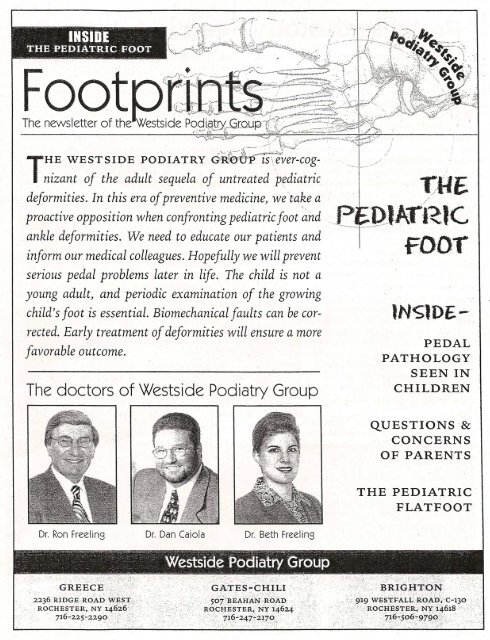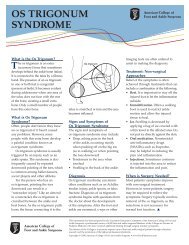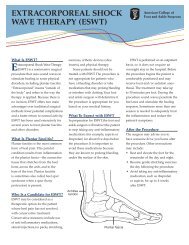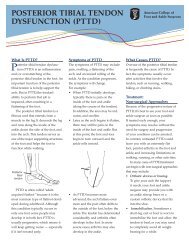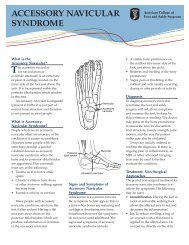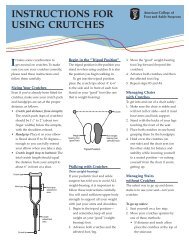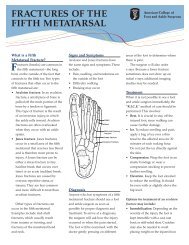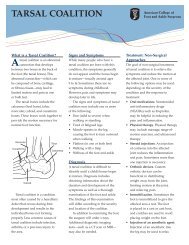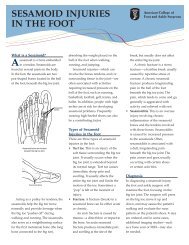the pediatric flatfoot - Westside Podiatry Group
the pediatric flatfoot - Westside Podiatry Group
the pediatric flatfoot - Westside Podiatry Group
You also want an ePaper? Increase the reach of your titles
YUMPU automatically turns print PDFs into web optimized ePapers that Google loves.
years of age and closure of <strong>the</strong> growth centers.Conservative treatments indude larger shoe gear, toespacers and orthotic devices.Orthotic devices are also <strong>the</strong> treatment of choice for acommon <strong>pediatric</strong> pathology known as calcaneal apophysitisor severs disease (see Figure 4). The calcaneal bone is<strong>the</strong> only bone in <strong>the</strong> body whose epiphysis assumes <strong>the</strong>body's entire weight prior to maturation and fusion to <strong>the</strong>primary ossification site. The" calcaneal apophysis firstappears in females at ages four to six and in males at agesseven to eight. The apophysis may present in a unipartite,bipartite or tripartite orientation. The multiple fragmentsof <strong>the</strong> apophysis may be easily confused as fracture fragments;however, it is a normal variant. Fusion of <strong>the</strong> secondarysite to <strong>the</strong> primary calcaneal bone may be completeas early as twelve years old in females and fifteen years oldin males.Inflammatory changes to <strong>the</strong> calcaneal apophysis is acommon condition seen in children between <strong>the</strong> ages ofeight and twelve years old. Pain and inflammation at <strong>the</strong>epiphysis is precipitated by acute or chronic trauma, obesityand biomechanical abnormalities. Pathomechanicmanifestations including pes plano valgus, torsional deformities,calcaneal valgus and tarsal coalition cause excessivesubtalar joint and midtarsal joint pronation in children.Pronation creates tension from <strong>the</strong> achilles tendonand plantar fascia on <strong>the</strong> calcaneus. The achilles tendoninserts in -<strong>the</strong> posterior proximal aspect of <strong>the</strong> apophysisand <strong>the</strong> plantar fascia originates at <strong>the</strong> inferior distalaspect of <strong>the</strong> apophysis. Pronation essentially creates a tugof war mechanism between <strong>the</strong> two tendons causinginflammation of <strong>the</strong> secondary growth center. The painand inflammation is exacerbated by sporting activities,barefoot walking and <strong>pediatric</strong> obesity. Many times this iswritten off to "growing pains," but growth should not bea painful process.On examination demonstrable pain is noted on lateralcompression to <strong>the</strong> posterior aspect of <strong>the</strong> calcaneus andwith direct pressure to <strong>the</strong> lower one third of <strong>the</strong> posteriorcalcaneus. Calcaneal apophysitis is always treated byconservative means as this condition is self limited uponfusion of <strong>the</strong> epiphysis. Initial treatment includes rest andcessation of sports, heel lifts and padding. Below kneecasting is an option in resistant cases. Custom moldedorthotics are quite beneficial as <strong>the</strong>y stop <strong>the</strong> traction of<strong>the</strong> plantar fascia and achilles tendon as well as providepadding to <strong>the</strong> sensitive heel.FIGURE 1: PLANTAR PEDAL WART FIGURE 2: PARONYCHIAFOOTPRINTS / FEBRUARY 2002 WESTSIDE PODIATRY GROUPPAGE 3


